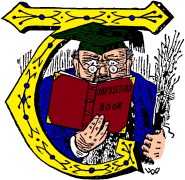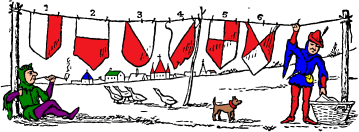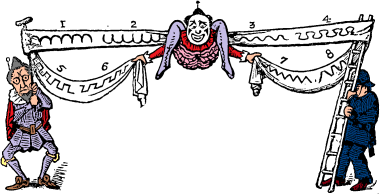HOME
Preface
Introduction
1
2
3
4
5
6
7
8
9
10
11
12
13
14
15
16
17
18
19
20
21
22
23
VII
CHAPTER VII.
OF LINES.
HE next members of the Heraldic family we shall present to our readers are Lines. They are not many in number; and as they are very easy to remember, we will go at them with a will.
Lines are used to divide the shield into two or more parts, and, like mothers-in-law in families, they bring about their divisions in different ways.
1. First of all there is the "Party per Pale," which has not, as might be expected, any connection either with a housemaid, a whitewasher, or a milkman, all of whom are necessarily parties with pails, but is simply a straight line drawn through the shield from top to bottom.
2. "Party per Fess," a horizontal line across the shield.
3. "Parted per Bend," a diagonal line from right to left. This naturally reminds us of bowing to a departing acquaintance; while the next (4), "Parted per Bend Sinister," a diagonal line from left to right, carries with it the same idea, as performed by a lawyer to a client against whom he is about to issue an immediate writ of execution for costs.
5. When the field is divided into four equal portions it is said to be quartered (traitors in olden times were served in a similar fashion and distributed as public ornaments, but we don't do that now, we have our public statues), but when by diagonal lines (6) forming a kind of St. Andrew's cross, it is said to be "parted by Saltire."
These divisions were made in order that several people's arms might be put in the same coat--an uncomfortable, not to say impossible arrangement, when applied to the garments of every-day life, but which Heralds made nothing of.
Besides the foregoing lines there are eight other varieties, exclusive of clothes lines, railway lines,--which latter sometimes prove imposition lines when they pay no dividend,--lines of argument, lines of defence, poetical lines, military lines, and hard lines.
1. The "invected," which consists of a series of semicircles turned downwards, and gives us the idea of a row of college puddings as purveyed at eating houses "a la slap dang."
2. The "engrailed," college puddings turned upside down.
3. The "wavy." Persons with very fertile imaginations can fancy this resembles the waves of the sea--we don't.
4. The "nebuly." As this line derives its name from the Latin nebula, a cloud, we suppose it is so called from its fancied resemblance to one; all we can say is, that the likeness is simply missed.
5. The "embattled," which represents battlements of a castle, and was probably borne by knights, who to battle meant to go.
6. The "raguly." This line is supposed, though we don't know who by, to look like the trunk of a tree with the branches cut short off--an arrangement which would do much towards facilitating an ascent; and this leads us to conclude that it denoted impecuniosity, or being up a tree. For our own part, we should rather liken it to the "embattled" in liquor.
7. The "indented." Here we have the teeth of a saw, a cutting allusion for which we confess ourselves unable to find a solution.
8. The "dancetty." The saw teeth again only blunted, and but three of them.
Which brings us to the end of the Lines, or perhaps it would be more correct to say to the Terminus; but they differ from those of a railway, inasmuch as there are no accidents upon them.
To change the subject we will now have a few differences, not of opinion, but of Blazonry.
VII
1
2
3
4
5
6
7
8
9
10
11
12
13
14
15
16
17
18
19
20
21
22
23
Preface
Introduction
HOME
Build: 2019/04/20 14:20:08.59+0900(JST)




